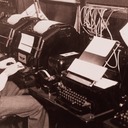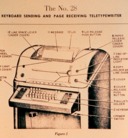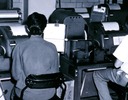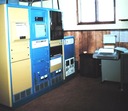[A note in case you got here through a web search: this site has no connection with NOAA or the NWS at all. I'm merely a Teletype enthusiast collecting images.]
The founding legislation of the National Weather Service mentions the "magnetic telegraph" explicitly, so it is not surprising that over the years what is now the National Oceanic and Atmospheric Administration has had teletypes in some interesting service.
[Act of Feb. 9, 1870, Sess. II, Res. 12, 16 Stat. 369 (1870)] ... " Be it resolved by the Senate and House of Representatives of the United Stat es of America in Congress assembled, That the Secretary of War be, and he hereby is, authorized and required to provide for taking meteorological observations a t the military stations in the interior of the continent, and at other points in the States and Territories of the United States, and for giving notice on the n orthern lakes and on the sea-coast, by magnetic telegraph and marine signals, of the approach and force of storms. APPROVED, February 9, 1870." { http://www.lib.noaa.gov/noaainfo/heritage/heritage.html}
The NWS timeline at http://www.erh.noaa.gov/er/gyx/timeline.html notes: "1928: The teletype replaces telegraph and telephone service as the primary method for communicating weather information."
The following images are all from various NOAA websites, as indicated for each. They are all in the public domain. Some of the "thumbnail" linking images are versions cropped from the overall version. In each case the "click-through" version is the full original image as downloaded from NOAA. In each case, I provide a link to the NOAA web page which contained the original images.
I find the Teletype maps particularly interesting, as they indicate what a large, but special-purpose, teletype network looked like.

Service A teletypewriter System
Circa 1960. (NOAA Central Library, source URL: http://www.photolib.noaa.gov/htmls/wea01820.htm)

Service C teletypewriter System
Circa 1960. (NOAA Central Library, source URL: http://www.photolib.noaa.gov/htmls/wea01819.htm)
Of course, while these maps indicate where the circuits were, the do not indicate how they were constructed. The 1961 edition of Principles of Electricity Applied to Telephone and Telegraph Work published by the Long Lines Department of AT&T indicates that at this time "The great majority of long-haul telegraph circuits in the Bell System are now obtained through the use of 'voice-frequency carrier systems' by means of which up to 18 two-way telegraph circuits are derived from a transmission facility that would otherwise be capable of use as a single telephone circuit." (p. 89) and later notes that "The original design of voice-frequency carrier telegraph system (40-Type) which is still extensively used ... provide[s] up to 18 two-way telegraph circuits." (p. 280). However, while this suggests that if the NWS was using Bell System telegraph circuits they would probably have been carried over 40-Type telephone circuits, it is by no means certain that they were.

Weather Operations, ca. 1944
"Hard at work in the teletype center - note teletype machines behind personnel Women's first opportunities in meteorology occurred as a result of WWII." Circa 1944. The Teletypes are in the background and are quite difficult to see. What is more interesting here is the overall context of their use in wartime weather reporting. (NOAA Central Library, source URL: http://www.photolib.noaa.gov/htmls/wea01306.htm)

Teletypes and Operator, ca. 1947
"Using a teletypewriter to transmit weather information." Circa 1947. (NOAA Central Library, source URL: http://www.photolib.noaa.gov/htmls/wea01816.htm)

Teletype Model 28 Brochure, ca. 1954
"Advertising brochure for teletypewriter used by Weather Service/" Circa 1954. (NOAA Central Library, source URL: http://www.photolib.noaa.gov/htmls/wea01817.htm)

Teletype Operators, ca. 1955
"Teletype Operators at the U. S. Weather Bureau Communications Center." Circa 1955. (NOAA Central Library, source URL: http://www.photolib.noaa.gov/htmls/wea01832.htm)

Teletype Operations, ca. 1955
"Teletypewriters in action; transmitting and receiving weather data from the U.S." Circa 1955. (NOAA Central Library, source URL: http://www.photolib.noaa.gov/htmls/wea01821.htm) It is interesting to compare the Teletypes here to those in the Washington National Airport in the Library of Congress images.

A Teletype in St. Louis
This image is probably misrepresented online. I don't yet know my Teletypes well, but this certainly looks to be a Model 28 ASR or similar unit. The caption, however, reads "The first teletype machines are installed, greatly improving communications." The machine shown cannot possibly date from 1939 (the paneling behind it doesn't look right for that date, either). I suspect that some writer simply grabbed an image of an "old teletype." (From History of the Weather Service in St. Louis, MO; source URL: http://www.crh.noaa.gov/lsx/stl-history.php) It is a very small image in the original (200x150 pixels).

Teletype in Antarctica, 1978
Ok, so this isn't a 5-level machine. It looks to be a Model 33 ASR. The caption reads "Inside the Clean Air Facility. The Computer Data Acquisition System. A 64K Digital Corporation computer interfaced to a teletype. Antarctica, South Pole Station. December 1978." (NOAA Central Library, "NOAA At The Ends of the Earth Collection," source URL: http://www.photolib.noaa.gov/htmls/corp1573.htm)
There is also a ca. 1972 photograph of a TTY 33 on an inshore survey boat on Lake Erie, at http://www.photolib.noaa.gov/htmls/theb4249.htm, but the photographic quality is so poor that I haven't included it here.
All of the Teletype images on this page are in the public domain. (All save one are official US government photographs and therefore in the public domain by law. The imge from the Teletype Model 28 brochure is in the public domain as copyrights on this vintage Model 28 literature were either not asserted or not renewed as then required.
All portions of this document not noted otherwise are Copyright © 2010 by David M. MacMillan and Rollande Krandall.
Circuitous Root is a Registered Trademark of David M. MacMillan and Rollande Krandall.
This work is licensed under the Creative Commons "Attribution - ShareAlike" license. See http://creativecommons.org/licenses/by-sa/3.0/ for its terms.
Presented originally by Circuitous Root®
Select Resolution: 0 [other resolutions temporarily disabled due to lack of disk space]